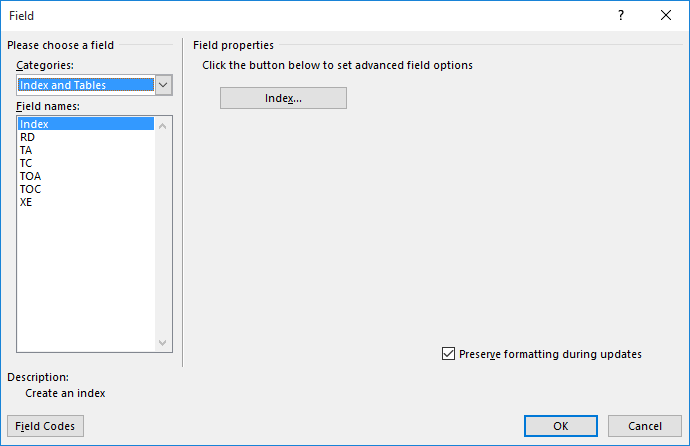Written by Allen Wyatt (last updated September 4, 2025)
This tip applies to Word 2007, 2010, 2013, 2016, 2019, 2021, and Word in Microsoft 365
Maurice has five Word documents, each of which is rather large. He needs to create a single index that covers all five documents, so he wonders if there is a way to do it without merging the five documents. He doesn't want to merge them because of their sizes.
There are two main ways you can do this. The first way is to create a master document that contains references to subdocuments, and then generate the index using the master document. (Both approaches covered here assume that your documents already have the index field codes inserted within them. In other words, this tip covers just the actual generation of the index, not the creation of the index entries.)
To create the master document, follow these steps:
The second way to create the index is to use fields to combine the documents into a single document. Follow these steps:

Figure 1. The Field dialog box.
The RD fields cause Word to reference each of the specified documents and include them in your index. If desired, you could also add the fields to the end of your fifth document rather than creating a blank document for the index. (If you do this you won't need to include a field for the fifth document itself; only the first four.) This assumes, of course, that you want the index to appear at the end of the fifth document.
WordTips is your source for cost-effective Microsoft Word training. (Microsoft Word is the most popular word processing software in the world.) This tip (13128) applies to Microsoft Word 2007, 2010, 2013, 2016, 2019, 2021, and Word in Microsoft 365.

Learning Made Easy! Quickly teach yourself how to format, publish, and share your content using Word 2021 or Microsoft 365. With Step by Step, you set the pace, building and practicing the skills you need, just when you need them! Check out Microsoft Word Step by Step today!
When you construct an index you need to insert all sorts of index fields throughout your document. If you want to later ...
Discover MoreIt is not unusual to need to convert one notation in a document into another entirely different notation. For instance, ...
Discover MoreIf you have a large document and need to create a complicated index, an AutoMark file can make your life much easier. ...
Discover MoreFREE SERVICE: Get tips like this every week in WordTips, a free productivity newsletter. Enter your address and click "Subscribe."
2025-10-22 22:40:00
Barbie
I'm curious... Does an index created in this way indicate in which document an entry appears, or is an entry on page 1 of any document just listed as being on page 1?
Got a version of Word that uses the ribbon interface (Word 2007 or later)? This site is for you! If you use an earlier version of Word, visit our WordTips site focusing on the menu interface.
Visit the WordTips channel on YouTube
FREE SERVICE: Get tips like this every week in WordTips, a free productivity newsletter. Enter your address and click "Subscribe."
Copyright © 2026 Sharon Parq Associates, Inc.
Comments